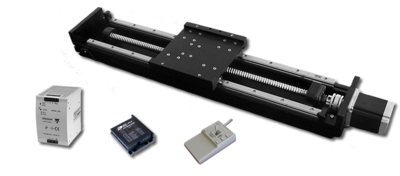Difference between revisions of "How to choose servo motors and drives"
| [checked revision] | [checked revision] |
(Created page with "Choosing suitable servo components for a linear motion machine is straightforward process. This article gives a method for choosing suitable servo motors and drives for a mach...") |
(→Choosing electromechanical parts) |
||
| (2 intermediate revisions by the same user not shown) | |||
| Line 20: | Line 20: | ||
| Track linear guide || Medium/high || High || High (Supported from whole length) || Medium | | Track linear guide || Medium/high || High || High (Supported from whole length) || Medium | ||
|- | |- | ||
| − | | Dovetail || Low || Medium/high|| High || Low | + | | Dovetail || Low/medium || Medium/high|| Medium/High || Low |
|- | |- | ||
| − | | Roller || Low/ | + | | Roller || Low/medium || Medium || Medium || High |
|} | |} | ||
| − | ===Choosing lead screw=== | + | |
| + | ===Choosing rotary-to-linear transmission=== | ||
| + | A typical solution to produce linear motion from rotary motor is to use a lead screw. There are mainly two kinds of lead screws: trapezoidal (sliding) and ball screw. Another common solution is to use belt or rack and pinion system. | ||
| + | {| class="wikitable" | ||
| + | |- | ||
| + | ! Type !! Cost !! Precision !! Stiffness !! Speed capability | ||
| + | |- | ||
| + | | Trapezoidal screw ||Low||Low||Low/medium||Medium | ||
| + | |- | ||
| + | | Ball screw (rolled)||Medium||Medium||High||Medium | ||
| + | |- | ||
| + | | Ball screw (ground)||High||High||High||Medium | ||
| + | |- | ||
| + | | Timing belt || Low ||Low||Low ||High | ||
| + | |- | ||
| + | | Rack and pinion||Low||Low||Low||High | ||
| + | |} | ||
| + | |||
| + | ====Transmission ratio and it's effect to performance==== | ||
| + | The resolution of transmission comes mainly from the transmission ratio: how much linear motion is produced per one revolution of motor (i.e. pitch of lead screw). Typical screw transmissions are between 2 mm/turn to 10 mm/turn while typical timing belt or rack & pinion systems have ratio of 20 to 100 mm per turn. | ||
| + | |||
| + | Higher ratio leads to higher speed capability but same time reduces stiffness, linear force and precision and vice versa. | ||
| + | |||
===Choosing motor=== | ===Choosing motor=== | ||
===Choosing motor drive=== | ===Choosing motor drive=== | ||
Latest revision as of 13:26, 12 March 2014
Choosing suitable servo components for a linear motion machine is straightforward process. This article gives a method for choosing suitable servo motors and drives for a machine with linear axis, such as CNC, 3D printing or pick'n'place systems.
Contents
Defining goals[edit | edit source]
The first step is to define goals of the system. Find numbers to the following questions:
- How much is the required linear force?
- How much is the maximum desired speed?
- What is the required accuracy (resolution, precision, repeatability)?
- What is the required stiffness / nature of mechanical load (stationary/vibrating)?
Choosing electromechanical parts[edit | edit source]
Choosing linear guides[edit | edit source]
Selection of linear guides have different choices to match desired speed range, stiffness, precision and cost. The following table summarizes most common choices with pros and cons:
| Type | Cost | Precision | Stiffness | Speed capability |
|---|---|---|---|---|
| Round linear bearing (sliding) | Low | Low | Low/moderate | Medium/high |
| Round linear bearing (ball) | Low/medium | Medium | Medium (Supported only at end points) | Medium |
| Track linear guide | Medium/high | High | High (Supported from whole length) | Medium |
| Dovetail | Low/medium | Medium/high | Medium/High | Low |
| Roller | Low/medium | Medium | Medium | High |
Choosing rotary-to-linear transmission[edit | edit source]
A typical solution to produce linear motion from rotary motor is to use a lead screw. There are mainly two kinds of lead screws: trapezoidal (sliding) and ball screw. Another common solution is to use belt or rack and pinion system.
| Type | Cost | Precision | Stiffness | Speed capability |
|---|---|---|---|---|
| Trapezoidal screw | Low | Low | Low/medium | Medium |
| Ball screw (rolled) | Medium | Medium | High | Medium |
| Ball screw (ground) | High | High | High | Medium |
| Timing belt | Low | Low | Low | High |
| Rack and pinion | Low | Low | Low | High |
Transmission ratio and it's effect to performance[edit | edit source]
The resolution of transmission comes mainly from the transmission ratio: how much linear motion is produced per one revolution of motor (i.e. pitch of lead screw). Typical screw transmissions are between 2 mm/turn to 10 mm/turn while typical timing belt or rack & pinion systems have ratio of 20 to 100 mm per turn.
Higher ratio leads to higher speed capability but same time reduces stiffness, linear force and precision and vice versa.
